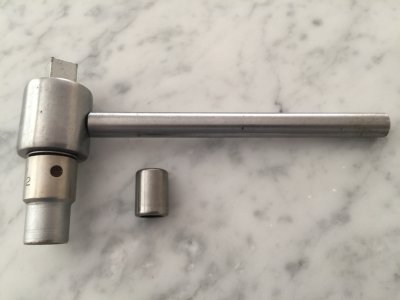- Joined
- Jul 15, 2020
- Messages
- 421
Back in my hot rod days, I often found myself in a situation where the space was too confining for my ratchet wrench to move back and forth between clicks -- an awkward way to explain it, but the best I can think of.
I came up with a wrench that used a one-way bearing that had zero backlash, if that's what one might call it. I came across it while cleaning out an old toolbox the other day, and thought I would share it. It was not the best fabrication, but it worked as long as a whole lot of torque wasn't required. To reverse it, I simply moved the socket to the other side.
I came up with a wrench that used a one-way bearing that had zero backlash, if that's what one might call it. I came across it while cleaning out an old toolbox the other day, and thought I would share it. It was not the best fabrication, but it worked as long as a whole lot of torque wasn't required. To reverse it, I simply moved the socket to the other side.


